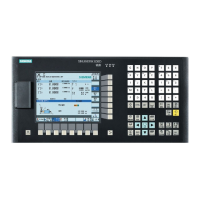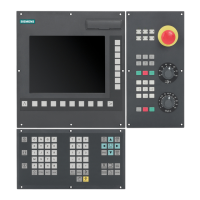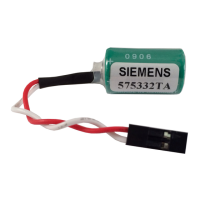Function Manual
34 01/2017
In some cases, an exact stop needs to be generated in continuous path mode to allow the execution of subsequent actions.
In such situations, the path velocity is reduced to zero.
● If auxiliary functions are output before the traverse motion, the previous block is only terminated when the selected
exact-stop criterion is fulfilled.
● If auxiliary functions are to be output after the traverse motion, they are output after the interpolator end of the block.
● If an executable block contains no travel information for the path axes, the previous block is terminated on reaching the
selected exact stop criterion.
● A block is terminated on interpolator end if the following block contains the changeover of the acceleration profile
BRISK/SOFT.
● If the function "Empty buffer" (STOPRE) is programmed, the previous block is terminated when the selected exact stop
criterion is reached.
Velocity = 0 in continuous path mode
Regardless of the implicit exact stop response, the path motion is braked down to zero velocity at the end of the block in
cases where:
● The time taken to position a spindle programmed with SPOS is longer than the travel time of the path axes. The block
change is carried out when the "exact stop fine" of the positioning spindle is reached.
● A synchronization process needs to be carried out (see Section "General (Page 32)").
Auxiliary function output during traversal
If the traversal time is not sufficient due to the programmed path length and velocity of the block with auxiliary function output,
the path velocity for the block is reduced such that the acknowledgment of the auxiliary function can arrive with a PLC cycle
time.
If the acknowledgment is not received within one PLC cycle time, the following prepared block cannot be processed and the
axes are braked to rest with setpoint = 0 (without considering the acceleration limits).
If the acknowledgment is not received by the end of the block in long blocks in which the velocity has not needed to be
reduced on account of the PLC acknowledgment time, the velocity is maintained until the end of the block and then reduced
as described above.
If the acknowledgment arrives while the axis is decelerating, the axis is not accelerated back up to the requested velocity.
Velocity reduction according to overload factor
Function
This function lowers the path velocity in continuous path mode until the nontangential
can be traversed in
one interpolation cycle whilst respecting the deceleration limit and taking an overload factor into account. With the reduced
velocity, axis-specific jumps in velocity are produced with a nontangential contour at the block transition. The jump in velocity
prevents the path velocity dropping to zero. This jump is performed if the axial velocity was reduced with the axial
acceleration to a velocity from which the new setpoint can be reached with the jump.
The magnitude of the setpoint jump can be limited using an overload factor. Because the magnitude of the jump is axial, the
minimum jump of the path axes which are active during the block change is considered during block transition. With a
practically tangential block transition, the path velocity is not reduced if the permissible axial accelerations are not exceeded.
In this way, very small angular changes in the contour can be overtraveled directly.
The overload factor restricts step changes in the machine axis velocity at the block transition. To ensure that the velocity
jump does not exceed the maximum load on the axis, the jump is derived from the acceleration of the axis. The overload
factor indicates the extent by which the acceleration of the machine axis, which is set in MD32300 MAX_AX_ACCEL (axis
acceleration), may be exceeded for an IPO cycle.
The velocity jump is the product of: axis acceleration * (overload factor-1) * interpolator cycle. The overload factor is 1.2.
Factor 1.0 means that only tangential transitions with finite velocity can be traversed. For all other transitions, the velocity is
reduced to zero by changing the setpoint.
